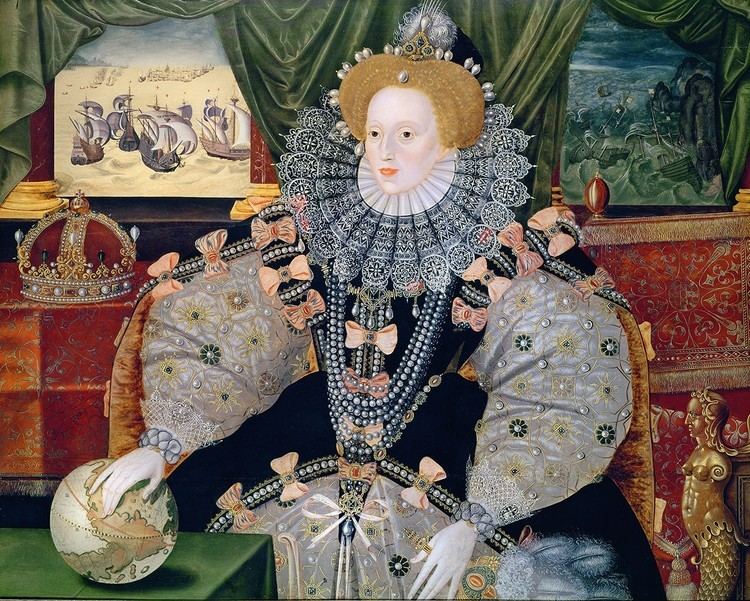Year 1588 | Created 1588 Media Oil paint, Oak | |
 | ||
Similar Plimpton Sieve Portrait of, Portrait of Henry VIII, Chandos portrait, Portrait of Anne of Austria, Portrait of Simonetta Vespucci | ||
Save the armada portrait
The Armada Portrait of Elizabeth I of England is the name of any of three surviving versions of an allegorical panel painting depicting the Tudor queen surrounded by symbols of imperial majesty against a backdrop representing the defeat of the Spanish Armada in 1588.
Contents
Iconography
The combination of a life-sized portrait of the queen with a landscape format is "quite unprecedented in her portraiture", although allegorical portraits in this format, such as the Family of Henry VIII: An Allegory of the Tudor Succession (1572) attributed to Lucas de Heere, pre-date the Armada Portrait.
English art in this period was isolated from trends in Catholic Italy, and owed more to Flemish manuscript illumination and heraldic representation than to Renaissance ideas of unity in time and space in art. The 'Armada Portrait' is no exception: the chair to the right is viewed from two different angles, as are the tables on the left, and the background shows two different stages in the defeat of the Armada. In the background view on the left, English fireships threaten the Spanish fleet, and on the right the ships are driven onto a rocky coast amid stormy seas by the "Protestant Wind". On a secondary level, these images show Elizabeth turning her back on storm and darkness while sunlight shines where she gazes, iconography that would be repeated in Marcus Gheeraerts the Younger's 1592 "Ditchley" portrait of the queen.
The queen's hand rests on a globe below a crown (probably not the state crown), "her fingers covering the Americas, indicating England's dominion of the seas and plans for imperialist expansion in the New World". The queen is flanked by two columns behind, probably a reference to the famous impresa of the Holy Roman Emperor, Charles V, Philip II's father, which represented the Pillars of Hercules.
Andrew Belsey and Catherine Belsey have pointed out the striking geometry of the painting, with the repeating patterns of circles and arches described by the crown, the globe, and the sleeves, ruff, and gown worn by the queen. They also contrast the imperial figure of the Virgin Queen wearing the large pearl symbolizing chastity suspended from her bodice and the mermaid carved on the chair of state, representing female wiles luring sailors to their doom, another interpretation is that the mermaid symbolizes Mary Queen of Scots. Elizabeth is facing away from Mary indicating that the plots and Mary's execution are all behind her and she doesn't worry about it anymore. The crown also symbolises the English monarch.
Versions
There are three surviving versions of the portrait in addition to several derivative portraits.
The first two portraits were formerly attributed to Elizabeth's Serjeant Painter George Gower, but curators at the National Portrait Gallery now believe that all three versions were created in separate workshops, and assign the attributions to "an unknown English artist"
